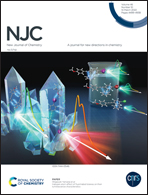Preparation of fluorescent organic nanoparticles via self-polymerization for tartrazine detection in food samples†
Abstract
Fluorescent polydopamine nanoparticles (PDA NPs) have been effectively synthesized by means of self-polymerization of dopamine under the strong alkaline condition of ethylenediamine at room temperature for 2.5 h. The obtained PDA NPs displayed excellent optical properties under the conditions of high ion strength and wide pH range. Utilizing the fluorescent signal of PDA NPs, a fluorescence turn-off sensor for tartrazine detection is proposed. The fluorescence signal changes linearly depending on the tartrazine concentration range of 1.5–45 μM, and a detection limit of 0.55 μM was obtained. The mechanism studies showed that the fluorescence quenching procedure is ascribed to the combined effects of the inner filter and the generation of non-fluorescent ground state complexes between PDA NPs and tartrazine via strong electrostatic interactions. The satisfactory results of the proposed sensor when applied to tartrazine detection in soft drinks and candies promise its practicality for real food samples.



 Please wait while we load your content...
Please wait while we load your content...